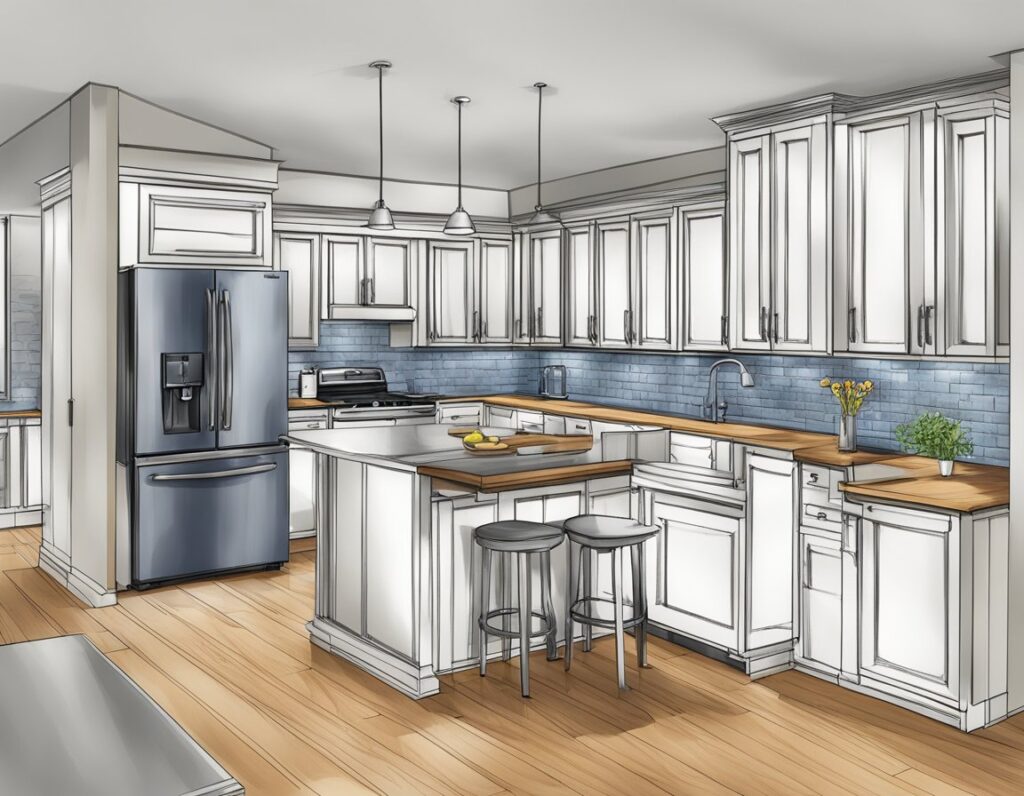Renovating your kitchen is a blend of art and practicality. The journey begins by envisioning the space you desire, considering both its aesthetics and function.
Creating detailed drawings is an indispensable step, enabling you to visualise each element of your kitchen before any physical work commences.
These plans serve as a blueprint for all decisions, from the selection of materials to the placement of appliances, ensuring that every aspect of your kitchen is perfectly tailored to your needs.

Utilising accurate drawings allows you to explore different layouts and design approaches efficiently.
At iamseb.co.uk we believe it’s essential to think about the workflow within the space and how you intend to use the kitchen daily.
Will you opt for the classic work triangle between the sink, fridge, and cooker, or do you prefer an island layout that facilitates social interaction and provides additional workspace?
Your drawings will help you navigate the myriad of layouts and design nuances, illustrating how your choices interact with one another within the space.
Key Takeaways
- Successful kitchen renovations start with detailed planning and design drawings.
- The right layout enhances both the kitchen’s look and its practical use.
- Drawings help foresee the interplay of different elements within the space.
Understanding Kitchen Layouts
When embarking on a kitchen renovation, it’s essential to have a grasp of the various layouts to ensure your space is not only aesthetically pleasing but also highly functional.
The Work Triangle Concept
In terms of design efficiency, the work triangle is foundational. This principle connects the three main work areas: the hob, the sink, and the refrigerator.
Ideally, the sum of the triangle’s three sides should not exceed 7 metres, and each leg should measure between 1.2 and 2.7 metres. This layout allows you to move quickly and easily between tasks.
Zoning for Efficiency
Zoning partitions your kitchen into dedicated areas for specific activities, such as food preparation, cooking, and cleaning.
For instance, positioning your cutlery and utensils near the food preparation zone while situating pots and pans near the cooking area simplifies your workflow.
With careful planning, these zones minimise foot traffic and maximise accessibility, making your kitchen renovation a triumph in both form and function.
Mastering Design Plans
When renovating your kitchen, having a solid design plan is a foundation for success. This includes drafting detailed floor plans, considering the necessary plumbing and electrical changes, and creating 3D renderings to visualise the space before construction begins. Here’s how to master each aspect.
Creating Detailed Floor Plans
To ensure efficiency and a smooth workflow in your kitchen, start with a detailed floor plan.
Measure your kitchen area accurately and account for all elements such as the total floor space and the placement of windows and doors.
Your plan should depict the location of each cabinet, appliance, and work surface.
You can use graph paper to make this process easier, aiming for a scale where one square represents a set measurement, say, 100mm.
Incorporating Plumbing and Electrical Plans
After finalising your floor plan, incorporate plumbing and electrical plans.
This involves indicating the positions of sinks, dishwashers, and any water-dependent appliances to ensure proper plumbing.
Similarly, map out electrical outlets, lighting fixtures, and switches in relation to your kitchen layout, considering the convenience of use and safety regulations.
Remember to consult with qualified electricians and plumbers to verify that your plans adhere to local building codes.
Visualising with 3D Renderings
Finally, transform your 2D plans into 3D renderings to visualise the outcome of your renovation project.
This will help you understand the spatial arrangement and flow of your kitchen. You can use kitchen design software for realistic images, experimenting with different materials and finishes.
It’s a fantastic way to see how the light affects your kitchen at different times of the day and to make confident decisions on the aesthetics and functionality of the space.